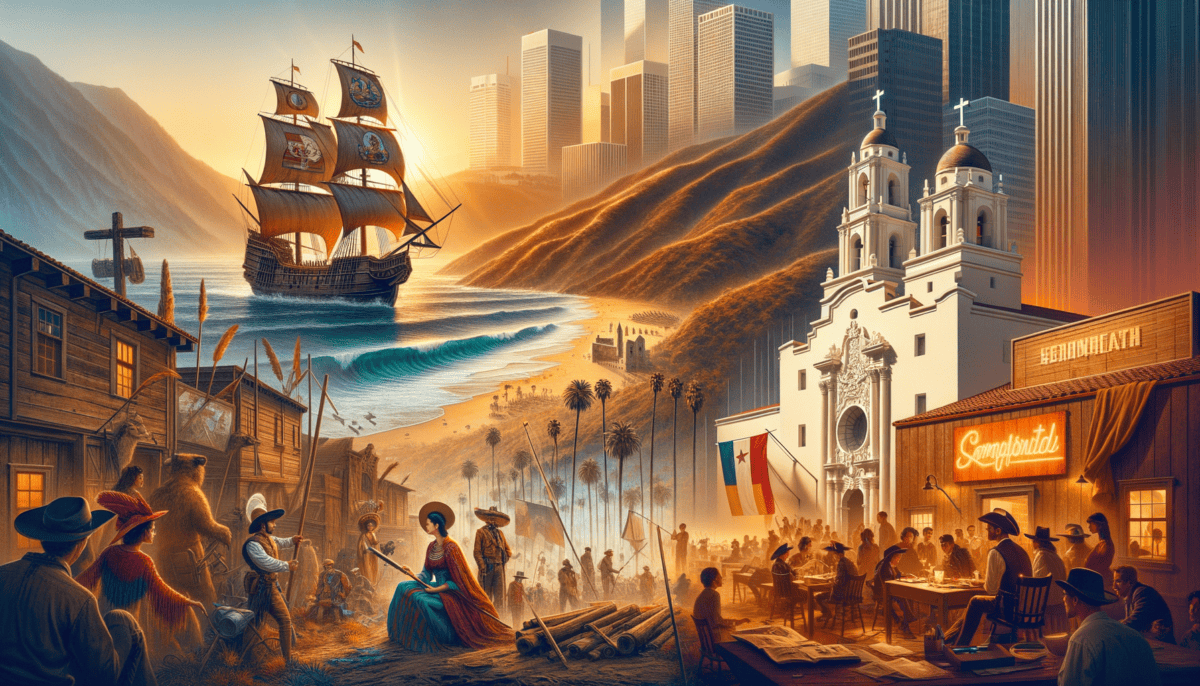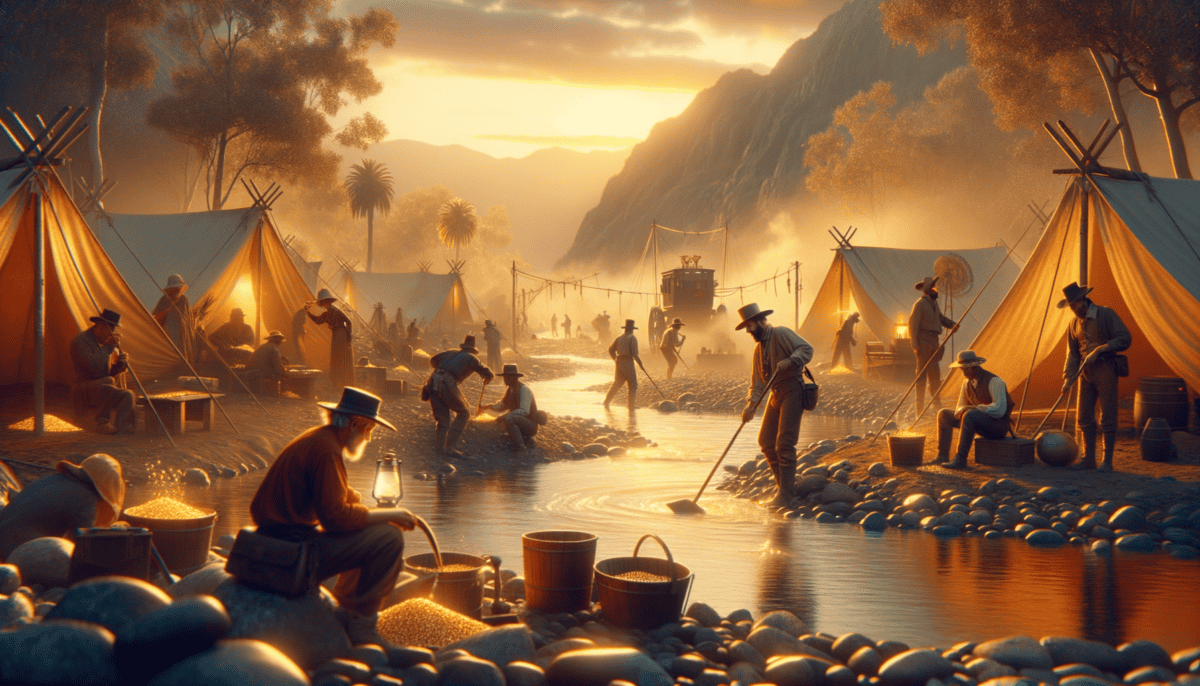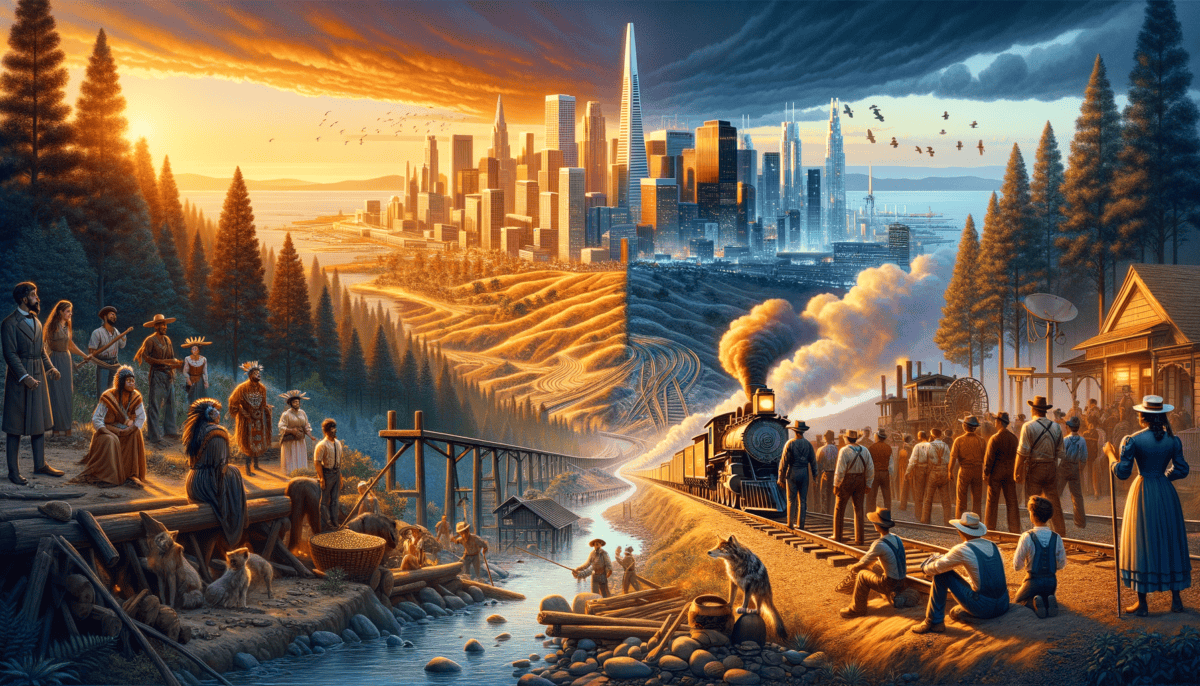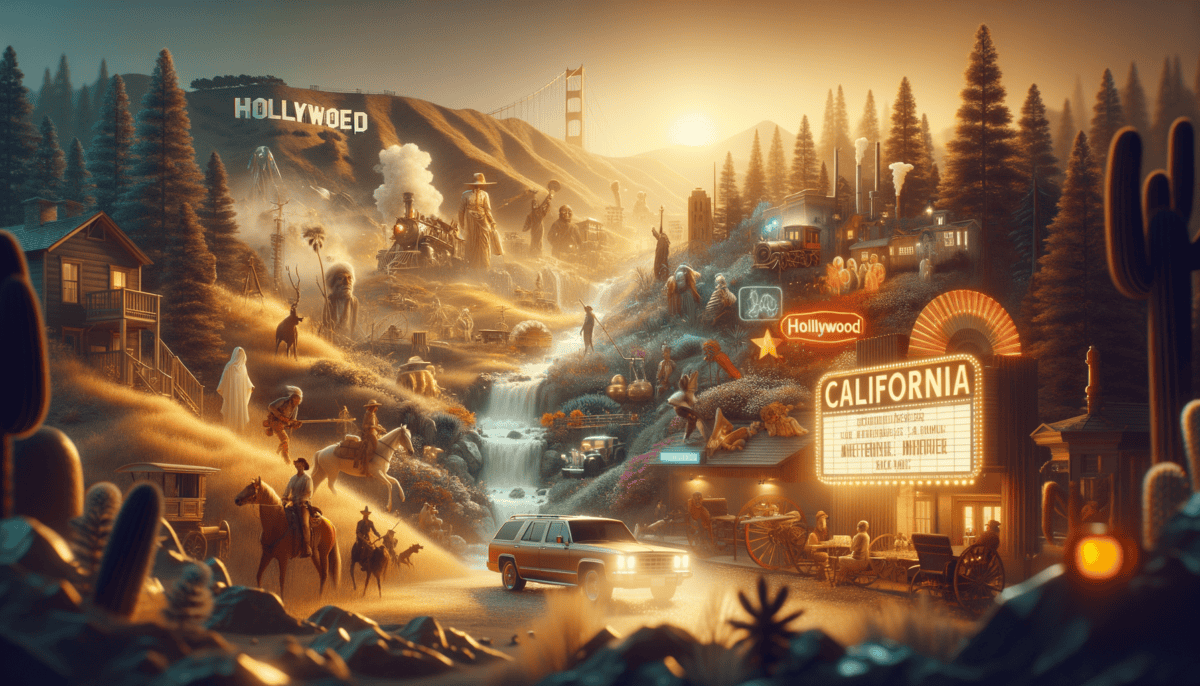The Land Before Gold
Long ago, before tall buildings and busy roads filled California, Native American tribes lived peacefully on the land. The Chumash, Miwok, and many other tribes called this beautiful place home.
"Look at those tall trees reaching up to the sky!" young Kosa said to his grandmother. They stood beneath giant redwood trees that seemed to touch the clouds.
His grandmother smiled. "These trees are older than our oldest stories, little one. They have watched over our people for many seasons."
The Native Americans didn't just live on the land – they took care of it. They knew exactly when to pick berries and which plants could heal sick people. They were like nature's best friends!
"Every plant and animal is our relative," Grandmother explained. "We must treat them with respect."
Life by the Ocean and Mountains
The Chumash people lived near the big blue ocean. They built special boats called tomols from tree bark. These boats helped them catch fish and visit nearby islands. ♂️
In the valleys, the Miwok people grew three special plants they called "The Three Sisters":
• Corn that grew tall and strong
• Beans that climbed up the corn stalks
• Squash that spread across the ground and kept the soil wet
Stories Under the Stars
At night, families would gather around warm fires. Elders told stories about how Bear got his short tail and why Coyote howls at the moon.
"Tell us another story!" the children would beg, their eyes sparkling in the firelight.
- Animal skins for clothes
- Tree bark for houses
- Shells for trading
- Plants for medicine
Living with Nature’s Beat
The tribes followed nature's rhythm like a beautiful dance. They moved with the seasons, following herds of deer and elk. They knew when salmon would swim up rivers and when acorns would fall from oak trees.
"The land gives us everything we need," Grandmother told Kosa. "We must give back to it too."
They had special ceremonies to thank Mother Earth. They sang songs of gratitude and danced to celebrate good harvests. The beat of drums echoed through valleys, and colorful feathers swayed in the wind.
“Our people have lived here since the first sunrise,” the tribal elder would say. “We are as much a part of this land as the mountains and rivers.”
The air was clean and fresh. Clear streams flowed from snowy mountain tops. Bears caught salmon in rushing rivers, and eagles soared high above. It was a peaceful time when people understood how to live as part of nature's big family.
Young Kosa looked up at the stars twinkling above. He felt lucky to live in such a beautiful place, where every day brought new adventures and every night brought magical stories. Little did he know that soon, very big changes would come to their peaceful land.
Spanish Shadows and Missionary Trails
The warm California sun shone down as strange ships appeared on the horizon. The year was 1769, and life was about to change for everyone living in this beautiful land.
“What are those giant canoes with white wings?” little Maria asked her father, a Native American of the Ohlone tribe.
“Those are Spanish ships,” he answered quietly. “They bring people from far away.”
The Arrival of Father Serra
A man named Father Junípero Serra led the Spanish missionaries. He wore a long brown robe and carried a wooden cross. The missionaries wanted to teach the Native Americans new ways of living.
“We bring you new stories about God,” Father Serra told the native people. “And we will teach you to farm like we do in Spain.”
Life Changes at the Missions
Big changes came to California. The Spanish built beautiful missions with red tile roofs and tall bells. But life became very different for the Native Americans who lived there.
“The bells ring to tell us when to wake up, when to pray, and when to work,” Maria explained to her younger brother. “It’s not like before when we followed the sun and seasons.”
- New ways to grow food
- How to raise cattle
- Spanish language
- Different customs
Growing Together, Growing Apart
Some good things happened when the Spanish came. They brought new animals like horses and cows. They taught people how to grow wheat and make olive oil.
But many Native Americans got sick because the Spanish brought new illnesses. Many missed their old way of life, living freely with nature.
“I miss our evening stories around the fire,” Maria’s grandmother said softly. “And the taste of fresh acorns we used to gather.”
A New California Takes Shape
As more Spanish people came, they built roads connecting the missions. These roads were called “El Camino Real” – The Royal Road. Many people still use parts of this road today! ️
The Spanish brought new foods too. They planted orange trees and grape vines. They started big farms called ranchos where cowboys called vaqueros rode horses and took care of cattle.
“Look how the land changes,” Maria’s father said. “Where there were once only deer paths, now there are wide roads. Where we once gathered wild food, now there are farms.”
Two Worlds Meet
The Spanish and Native American cultures began to mix together. Children like Maria learned to speak both Spanish and their native language. They ate new foods and learned new songs, but they also remembered their old ways.
People learned to make beautiful things together. Native Americans taught the Spanish about local plants that could heal sick people. The Spanish taught Native Americans how to make tools from metal instead of stone.
As the sun set over the mission’s bell tower, Maria watched the stars come out. They were the same stars her ancestors had watched for thousands of years. Even though so much had changed, some things stayed the same. The land was still beautiful, and it was still home.
The Spanish time in California had begun, bringing big changes to the golden land. But even bigger changes were coming – changes that would turn California into a place that neither the Native Americans nor the Spanish could have imagined.
The Glittering Promise of Gold
One sunny morning in 1848, James Marshall was checking on his sawmill at Sutter’s Fort when something sparkly caught his eye.
“What’s that shining in the water?” he wondered aloud, reaching into the cold stream. What he found would change California forever – it was gold!
The Big Rush Begins
“There’s gold in California!” The news spread like wildfire. People from all over the world packed their bags and headed west. Some came by ship, others walked for months across land.
Little Tommy watched from his family’s farm as wagons rolled by. “Where is everyone going, Pa?” he asked.
“They’re chasing dreams of gold, son,” his father replied. “They think they’ll get rich quick!”
A Rainbow of People
California became like a giant mixing bowl of people. Chinese workers came across the ocean. Mexican miners traveled north. African Americans sought freedom and fortune. European settlers crossed the sea. Each group brought their own food, music, and stories.
“Look at all the different languages you can hear in the mining camps!” Tommy exclaimed. “It’s like the whole world came to California!”
Life in the Gold Fields
- Pans for washing gold
- Shovels for digging
- Picks for breaking rocks
- Cradles for sifting dirt
Mining was hard work! People stood in cold streams all day, shaking pans of dirt and rocks. Some got lucky and found big gold nuggets. Most found only tiny pieces called “gold dust.”
“My back hurts, but maybe tomorrow will be the lucky day,” said Chen, a young miner from China, as he soaked his tired feet.
Growing Towns
Tiny camps grew into busy towns overnight! Stores sold picks and shovels. Restaurants served hot meals. Hotels gave tired miners a place to sleep.
San Francisco changed from a small town of 800 people to a big city of 25,000 in just one year! People built houses, schools, and churches as fast as they could.
Not All That Glitters
Life wasn’t easy during the Gold Rush. Food cost a lot of money. Many people got sick. Some miners fought over good spots to find gold.
Native Americans and Mexican people who already lived in California often lost their homes and land to miners. The rush for gold changed their lives forever.
More Than Just Gold
Something amazing happened during the Gold Rush. While not everyone found gold, they found other ways to make money. Some opened stores. Others started farms. Many built new roads and buildings. ️
“Maybe the real gold,” Tommy’s mother said wisely, “isn’t just the shiny stuff in the streams. It’s all the new people and ideas that came to California.”
A New California
By 1850, California had so many people it became a state! The Gold Rush brought people who built cities, started businesses, and made California their new home. ️
Tommy watched his town grow bigger every day. “Will more people keep coming?” he asked his father.
“Yes, son,” his father smiled. “California is like a magnet now. People will keep coming to chase their dreams – even when all the gold is gone.”
The Gold Rush changed California from a quiet place into a busy, exciting land where people from all over the world came to find their fortune. But this was just the beginning of California’s big changes. More adventures and opportunities were just around the corner.
Building a New Frontier
The trains came roaring into California like giant iron dragons! After the Gold Rush, people needed better ways to travel and move things across the state.
“Listen to that whistle!” little Maria shouted, jumping up and down as she watched the first train roll into town. “It’s like magic!”
The Iron Road
Building the railroad was super hard work. Brave workers had to dig through mountains and build bridges over deep valleys. Many Chinese workers helped build the tracks, working day and night.
“One mile today, another tomorrow,” said Li Wei, a railroad worker. “Soon we’ll connect California to the whole country!”
Growing Food in the Valley
While some people built railroads, others found out that California’s soil was perfect for growing food! The Central Valley became like one giant garden.
“Look at all these oranges!” Maria’s father said proudly, showing her their new orange grove. “We can send them all over America on the new trains!”
- Juicy oranges and lemons
- Sweet grapes
- Crunchy almonds
- Fresh vegetables
Big Cities Growing Up
San Francisco grew into a big, busy city by the bay. Tall buildings reached up to the sky, and boats filled the harbor. Ships brought things from far away places.
Down south, Los Angeles was getting bigger too! People built houses, stores, and schools. They planted palm trees along the streets.
“Every day there’s something new!” Maria told her friend. “Yesterday they opened a whole new street of shops!”
Many Helpers, Many Stories
People from all over the world helped build California. Mexican farmers knew how to grow crops in warm weather. Chinese workers built railroads and started businesses. Japanese families grew beautiful fruit orchards.
“Each person brings something special,” Maria’s teacher explained. “That’s what makes California strong!”
New Ways to Work
Some people found clever ways to make money. They opened banks to keep gold safe. Others built stores to sell tools and clothes. Some started newspapers to tell everyone the news.
Working Together
Building California wasn’t always easy. Sometimes people didn’t get along. Some workers weren’t treated fairly. But many brave people stood up and said everyone should have a chance to succeed.
“We’re all building California together,” Maria’s mother would say. “Everyone deserves to be treated with respect.”
A New Home for Dreams
By the time the railroads were finished, California looked very different. Farms filled the valleys. Cities grew bigger. Trains connected towns that were far apart. ✨
Maria loved watching her state grow. “What’s next for California?” she asked her father one evening.
“Oh, just wait and see,” he smiled. “California is a place where dreams come true. Something exciting is always just around the corner!”
The railroad tracks stretched like silver ribbons across the land, and California’s future was bright with promise. New ideas and inventions would soon bring even more changes to this amazing place.
Lights, Camera, Silicon!
The sun was setting over Los Angeles when young Tommy first saw the giant HOLLYWOOD sign on the hill. “Wow!” he gasped. “That’s where they make movie magic!”
Movie Stars and Dream Makers
“Action!” called the director. Cameras rolled as actors told stories that would make people laugh and cry. Hollywood became the place where dreams came to life on the big screen.
“My grandpa says movies used to cost just five cents!” Tommy told his friend Sarah. “Now they make movies that look so real, you feel like you’re flying!”
Computer Valley
Up north, in a place called Silicon Valley, smart people were building something new – computers!
“These machines will change the world,” Sarah’s mom explained. “They help us learn, play, and talk to people far away!”
- Phones that fit in your pocket
- Computers that help doctors
- Games that teach while you play
- Cars that drive themselves
Ideas That Changed Everything
California became a place where new ideas grew like flowers. People weren’t afraid to try new things. If something didn’t work, they tried again!
“Remember when phones were stuck to the wall?” Tommy’s dad laughed. “Now we can video chat with Grandma in New York!”
Sharing California’s Stories
Movies and TV shows made in Hollywood showed the world what life was like in America. People everywhere watched California’s stories.
Smart People, Big Dreams
Students from all over the world came to learn at California’s great schools. They studied stars, built robots, and thought up new ways to help people.
“My sister is learning how to make clean energy from the sun,” Sarah said proudly. “She wants to help save the planet!” ☀️
Games and Fun
California didn’t just make serious things. People made fun video games, cool toys, and amazing theme parks where families could play together.
“It’s like California knows how to make people smile,” Tommy said, playing his favorite game.
Changing the Future
The new ideas from California changed how people lived all over the world. From phones to electric cars, California’s dreamers kept thinking up new ways to make life better.
“What will they think of next?” Tommy wondered, looking at the stars through his telescope.
Sarah grinned. “Something amazing, for sure! That’s what California does – it makes the future happen!”
As the sun set behind the Hollywood sign, Tommy and Sarah knew they lived in a special place. California wasn’t just about movies and computers – it was about believing that anything was possible.
Dreams of Tomorrow
The morning sun sparkled over the California coast. Tommy and Sarah sat on the beach, watching waves roll in. “Our state has changed so much,” Sarah said, picking up a seashell.
Earth Heroes
“Look!” Tommy pointed to people cleaning the beach. “They’re helping keep our ocean clean!” Kids and grown-ups worked together, picking up trash and recycling.
- Solar power farms
- Electric cars and buses
- Ocean cleanup teams
- Tree planting groups
Standing Together
“My mom says California is like a big family,” Sarah smiled. “We help each other and work to make things better for everyone.”
“When someone needs help, Californians show up!” Tommy added. “Remember when the whole town helped rebuild after the wildfire?”
Growing Green
All over California, people were finding new ways to protect nature. Farmers grew food using less water. Scientists worked to save endangered animals.
Cities of the Future
California’s cities were changing too. Buildings had gardens on their roofs. Bikes and skateboards shared special lanes with scooters. Electric buses quietly zoomed by.
“My dad says we’re building cities that work with nature, not against it,” Tommy explained.
New Ways to Learn
Schools in California tried exciting new ideas. Kids learned about computers, grew vegetables in school gardens, and studied different languages.
“I love that we can learn from people all around the world,” Sarah said, waving to her virtual pen pal on her tablet.
California Dreams Big
Looking out at the ocean, Tommy and Sarah thought about all the amazing things that started in California – from gold rush dreams to Hollywood movies to Silicon Valley computers.
“What do you want to be when you grow up?” Sarah asked.
“I want to build robots that help clean the ocean,” Tommy replied. “How about you?”
“I want to make movies about saving the planet,” Sarah smiled. “Maybe we can work together!”
The Story Continues
The sun was high now, warming the sand. A group of kids ran by, speaking different languages, laughing together.
Tommy stood up and brushed off the sand. “That’s what makes California special,” he said. “Everyone can write their own story here.”
Sarah nodded. “And the best part is, our story isn’t over. It’s still being written, every single day!”
As they walked home along the shore, Tommy and Sarah knew they were part of something bigger – a place where dreams come true, where people help each other, and where tomorrow’s stories are just beginning.






